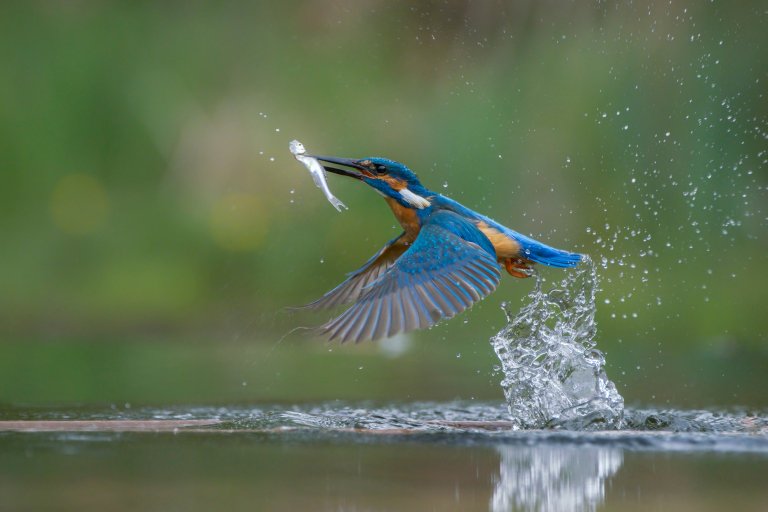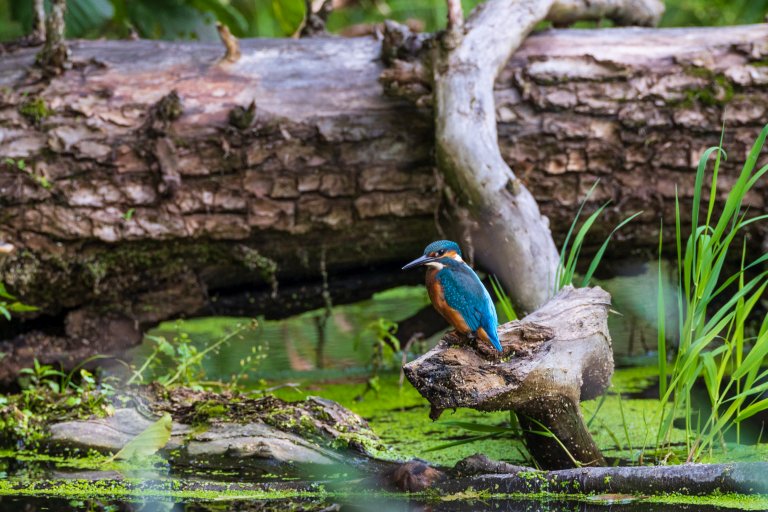Common Kingfisher Profile
The common kingfisher is a beautiful, iridescent-blue bird found throughout Europe and in countries across Asia, and North Africa.
Like most species of kingfisher, these birds are rarely found far from water, often seen perched on branches overhanging rivers and streams.
The common kingfisher is a relatively small bird with a wingspan of around 25cm and a long, strong beak; perfectly designed for catching fish under the water’s surface.
As well as small fish, they will also catch insects and even small crabs, waiting patiently until the perfect moment to dive head first at their prey.

Common Kingfisher Facts Overview
| Habitat: | Shores of streams, rivers, lakes, dams and other water sources |
| Location: | Europe, Asia and Africa |
| Lifespan: | Average 7 years |
| Size: | Average 16cm in length |
| Weight: | Up to 40g |
| Color: | Iridescent blue covering the upper body surface. Chestnut brown underneath with a white throat. |
| Diet: | Mainly small fish, also eats insects and small crabs |
| Predators: | Smaller carnivores, such as snakes, monitor lizards and weasels |
| Top Speed: | Around 40 kph (25 mph) |
| No. of Species: |
1 |
| Conservation Status: |
Least Concern |
Despite their striking plumage, the common kingfisher is not particularly easy to spot in the wild as they tend to be quiet, shy birds, perching silently waiting for their prey to appear. They are rather compact with large heads to support their long beaks.
The common kingfisher prefers habitats in which there are ample perches a few metres above, slow flowing water. As small fish are their main prey, the common kingfisher is very susceptible to water pollution and thus they are usually found fishing in unpolluted and clean streams, rivers and canals.
Similar to other kingfisher species, the common kingfisher is very protective of its territory, with both males and females being incredibly territorial.
Although they are mainly solitary birds, common kingfisher mating pairs remain together during the breeding season. Both the male and female will excavate a hole in the side of a preferably steep cliff, often on the banks of a river of stream.
As well as the attraction for bird watchers, the common kingfisher is also an indicator species; their presence an indication of ecosystem health.
They are often one of the top predators along waterways and therefore are usually at the top of the food chain. Where kingfishers are abundant, this is a sign that the water source is unpolluted and thereby indicating that that specific ecosystem is in good health.
Despite the old myth that kingfishers detrimentally affected fish numbers, they actually control fish populations, thus ensuring a balanced food chain in that habitat.
Interesting Common Kingfisher Facts
1. Males and females are easy to distinguish from one another
Though their plumage is the same, male common kingfishers have all-black beaks, where a female’s lower part of her beak is red-brown. 1

2. Common kingfishers have to eat a lot
The common kingfisher must eat over half of its body weight each day in order to survive.
It is therefore no surprise that they are excellent fishers as well as being very territorial around their favourite fishing spots.
3. They are experts in fishing
These birds are perfectly designed for their fishing lifestyle, with superb vision, rapid flight, strong beak and water-repellent feathers to avoid too much water entering their plumage while underwater.2
4. They have a third eyelid which helps protect their eyes in the water
They have excellent vision, which allows them to spot fish under the water’s surface. Although their vision is not as sharp underwater, they can see well while submerged, allowing the kingfisher to catch prey swimming over 20cm underwater.
A third eyelid protects the surface of their eyes while immersed and strong head and neck muscles reduce the impact when they dive into the water.

5. Common kingfishers vary their diet depending on the season
When certain fish species are absent due to changing water temperatures, the common kingfisher may switch to hunting insects or crabs.
6. Not all kingfishers eat fish
Although the common kingfisher eats mostly fish, some woodland kingfishers such as the kookaburra in Australia and New Guinea, rarely eat fish and instead feed on terrestrial small animals.
7. The common kingfisher can appear to have many different colours
Due to their iridescent plumage, their colour can change depending on the angle of sunlight hitting their feathers.
8. They swallow their prey whole
Once they have grabbed their prey and flown head first back out the water, they return to their perch.
Here they stun their prey by beating it against a branch or other hard object, before swallowing it.
After swallowing their prey headfirst and whole, the common kingfisher regurgitates a pellet containing the undigested bones and scales.

9. These kingfisher almost always nest in cliff faces
Although most nests are around 20cm deep holes in a cliff face, some nest tunnels may be over 1 metre deep.
10. They are sometimes spotted in more urban areas
Where man-made garden ponds contain appropriately sized fish and are large enough, it is not uncommon to see a kingfisher perching above on a suitable branch.
11. Common kingfishers do not sing
This species does not have a bird song, instead they produce a shrill, repetitive whistle when courting or when alarmed.
12. The common kingfisher will migrate to warmer climates
Although they are found in cooler climates, they cannot tolerate freezing conditions and birds in these areas usually migrate further south in the winter.
They are strong fliers over short distances but when migrating they make regular stops on their journey in order to feed and rest.
13. Kingfisher chick mortality rates are high
Parents have to catch fish of a specific size for their young, holding the fish by the tail and pushing it headfirst into the chicks mouth. After just under a month, the chicks leave the nest and the parents separate, often finding a different mate the next breeding season.
Even though the common kingfisher is an expert fisher and can breed up to 3 times a year, most young kingfishers do not successfully survive to adulthood. The art of diving into water and catching a fish is difficult to learn and many young kingfishers either drown or do not catch enough food to survive.
The parents themselves often struggle after their chicks fledge, having used up too much energy fishing for their offspring and protecting their nest. However once young kingfishers has mastered their craft, they have few natural predators and can survive to over 15 years old.
14. Raising chicks takes its toll in kingfisher parents
Due to their own food requirements and trying to feed sometimes up to 10 chicks, some kingfisher parents become too exhausted after breeding and die shortly after.
15. Kingfishers will hold each other underwater during fights
When not breeding, they are solitary animals and have specific favourite perches, which they will defend from intruders.
These meetings are usually solved by displays of their beaks and plumage, they may also fight, attempting to hold the other bird underwater!
When faced with a predator, the common kingfisher may fly rapidly at the approaching animal in the hope of chasing them away.
16. Kingfishers are often considered to be a symbol of wisdom and power
Due to their prowess in fishing and their beautiful colours, the kingfisher is often revered in many different cultures. 3

Common Kingfisher Fact-File Summary
Scientific Classification
| Kingdom: | Animalia |
| Phylum: | Chordata |
| Class: | Aves |
| Order: | Coraciiformes |
| Family: | Alcedinidae |
| Genus: | Alcedo |
| Species Name: |
Alcedo Atthis |
Fact Sources & References
- “Alcedo atthis”, ITIS.
- “Kingfisher Bird Facts”, RSPB.
- Habibon Naher (2021), “Breeding biology of common kingfisher (Alcedo atthis, Linnaeus 1758)”, Research Gate.
